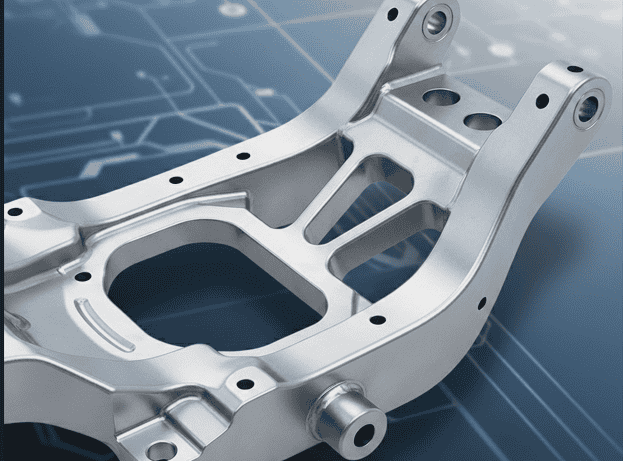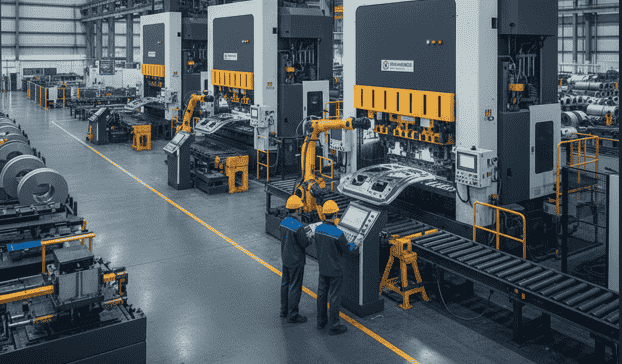Automotive cold heading: a definitive guide
Automotive cold heading has established itself as an essential process in the manufacture of fasteners and fasteners that demand maximum precision, strength and competitive costs. This technique is capable of producing complex parts with very tight tolerances and a high quality finish, characteristics that have made it a standard in the demanding automotive industry. In an industry where safety and performance are crucial, cold heading represents the perfect combination of productivity, cost savings and end-product reliability.
What are automotive fasteners?
Automotive fasteners are essential components in the automotive industry, designed to securely and durably join the various parts, structures and systems of a vehicle. Their primary function is to ensure that assemblies hold together, withstand dynamic loads, resist extreme vibrations and meet the most stringent design specifications.
From the chassis to the engine, suspension systems to body elements, these fasteners are the foundation that ensures the stability, safety and proper functioning of any automobile. The right choice and precise manufacture of screws, bolts, nuts and special parts are crucial to the durability and performance of the vehicle, making cold heading a vitally important method.
Materials most commonly used in the manufacture of automotive fasteners by cold heading

The choice of material is one of the most critical factors in the manufacture of automotive fasteners, as it determines their strength, durability and performance under various conditions.
- High Strength Cold Stamping Steels: These steels provide the hardness, mechanical strength and durability required for fasteners that withstand high loads and stresses in the automotive industry. They are ideal for structural and safety components.
- Specific Alloys: The automotive industry also uses alloys with specific properties, such as increased lightness or corrosion resistance, depending on the end application.
The choice between different types of steel or alloys depends on the final application within the vehicle: while a high-strength steel bolt may ensure the structural safety of the chassis, other materials may be preferable to reduce weight in non-critical components.
Types of common automotive fasteners manufactured by cold heading
Automotive fasteners and fasteners cover a wide range, with cold heading being the predominant method of manufacture.
- Screws: These are threaded elements that attach to a material, creating an internal threaded joint or coupling with a nut. In the automotive industry, they are used in engines, suspension systems and car bodies, offering versatility for temporary or permanent assemblies.
- Nuts: Internally threaded parts that attach to the shank of a screw or bolt, securing the joint. There are safety variants designed to prevent loosening due to vibrations, crucial in vehicles.
- Bolts: Cylindrical fasteners, often stronger than screws, designed for use with nuts. They are used in joints where higher tensile and shear strength is required, such as in chassis or heavy components.
- Special Fasteners: These include elements such as rivets for car bodies, spacers or specific fastening components for cable terminals or electronic systems, all of them manufactured with high precision by cold heading.
Need help?
Contact our technical office and tell us about your project.
We will study your case and propose a solution to manufacture them.
Types of cold heading processes for automotive fasteners production
In the automotive industry, cold heading processes have diversified to meet complexity and volume requirements.
- Progressive Stamping: Allows several operations to be performed sequentially on the same die, speeding up the production of mass fasteners, such as standard screws.
- Multi-station stamping: An advanced method that manufactures complex fasteners in different work phases, optimizing times and reducing material waste. It is especially relevant for producing high-precision fasteners, bolts and industrial rivets with elaborate geometries.
The latter process is key for automotive safety fasteners, ensuring the required uniformity and strength of critical components .
Step-by-step process: how we manufacture high quality automotive fasteners
The manufacturing of automotive cold heading fasteners follows a rigorous sequence that guarantees quality and precision.
- Material Selection: The type of high strength steel or specific alloy is defined according to the application and automotive regulations.
- Die Design and Construction: Specific tools (dies) are developed for each type of fastener, with extremely tight tolerances.
- Pressing and Forming: The metal wire is introduced into the press, where it is molded through different stations to obtain the desired shape.
- Additional Operations: This may include trimming, bending, threading (by rolling) or punching, depending on the fastener.
- Surface Treatments: Application of anticorrosive coatings (zinc plating, galvanizing) or heat treatments to improve strength and durability.
- Finishing and Quality Control: The fasteners are verified to comply with the strict automotive norms (ISO, DIN, ASTM) and the required technical standards.
This process makes it possible to obtain large volumes of uniform, high-strength parts ready to meet the most demanding requirements of the automotive sector.

Specific advantages of manufacturing fasteners by cold heading for the automotive industry
Cold heading of fasteners offers decisive advantages over other methods in the automotive industry.
- High Production Speed: Allows to meet the high demands of the automotive industry.
- Increased Mechanical Strength: Cold work hardening increases the strength of the parts, essential for vehicle safety.
- Superior Dimensional Accuracy: Crucial for fasteners subjected to vibration and constant loading in vehicles.
- Material and Cost Savings: Optimizes the use of wire without generating chips, which reduces waste.
- Optimum Surface Finish: Facilitates thread rolling and improves the fatigue behavior of the part.
- Sustainability and Energy Efficiency: Reduces energy consumption compared to hot stamping.
Threading of automotive cold heading: practices, standards and quality control
Threading of automotive parts is an essential step following cold heading. It is mainly performed by thread rolling, a process that ensures the continuity of the material’s fibers, which results in fatigue and tensile strength superior to traditional machining.
International standards such as ISO, DIN and ASTM define the tolerances, finishes and tests necessary to ensure that automotive fasteners withstand vibrations, fatigue and corrosive environments. In addition, anti-corrosion coatings (zinc plating, galvanizing) and heat treatments are applied when required by the application, guaranteeing the durability and reliability of the fasteners.
Glossary of applicable automotive standards for cold heading fasteners
| Standard | Description | Application |
|---|---|---|
| ISO 898 | Specifies mechanical properties of steel screws, bolts and nuts. | Minimum strength, hardness and elongation in fasteners for engines, suspensions and chassis. |
| DIN 931/933 | German standards for dimensions and characteristics of hexagonal bolts. | Standardizes the fasteners used in structural joints and critical parts of the vehicle. |
| ASTM A193/A194 | They regulate materials and properties of high-strength fasteners. | They are applied in demanding environments, such as engines, transmissions and parts subjected to heat and vibration. |
| ISO 965 | Establishes tolerances and dimensional parameters for metric threads. | Ensures that threading on automotive fasteners is compatible and secure in any assembly. |
| ISO 4042 | Regulates metal coatings and surface treatments for fasteners. | Defines requirements for zinc plating, galvanizing and corrosion protection for parts exposed to aggressive environments. |
Main applications of cold heading fasteners in the automotive industry
Metal fasteners manufactured by cold heading are used in various areas of the automotive industry:
- Chassis and Body: High-strength structural screws, bolts and rivets.
- Motors and Transmissions: Screws and threaded elements for assembly and internal operation.
- Suspension Systems: Bolts and nuts ensure safety and dynamic performance.
- Vehicle Electronics: Special screws and spacers for electronic components.
- Braking Systems: Critical fasteners that withstand high temperatures and stresses.
Proper fastener selection depends on factors such as mechanical loading, vibration conditions, exposure to aggressive environments and vehicle-specific safety regulations.
Innovation in the manufacture of automotive metal fasteners by stamping
Innovation in cold heading applied to the manufacture of metal fasteners for the automotive industry is focused on two main aspects: raw materials and advanced machinery.
- Raw Materials: The development of processes capable of working with ultra-high strength steels (1500 MPa or more), used in automotive components that require maximum safety and weight reduction, has been achieved.
- Machinery and Dies: Multi-station stamping has made it possible to manufacture fasteners with increasingly complex geometries, reducing costs and production times without compromising quality. This has been made possible by advances in machinery and the development of high-precision dies. Automation of production lines and digital process control are increasing productivity and reducing errors.
How to request manufacturing or quotation of automotive fasteners
If your company needs industrial fasteners by cold heading for the automotive sector, it is advisable to contact our technical office so that we can provide you with the best solution:
- Let’s analyze your specific need, considering vehicle and application specifications.
- Select the appropriate material (high strength steels, alloys, etc.) according to regulations.
- Let us design the necessary dies with tight tolerances and a focus on optimization.
- Specify finish grades, surface treatments (anti-corrosion), tolerances and lead times that meet automotive standards.
Get in touch with us
Contact our technical office and tell us what kind of steel parts you need to manufacture.
We will study your case and propose a customized, fast and efficient cold stamping solution.
Frequently asked questions on automotive cold heading FAQ’s
Which automotive fasteners are manufactured by cold heading?
Mainly screws, bolts, nuts, rivets and special fasteners for engines, chassis, bodywork and safety systems.
Why is the use of high performance steels beneficial in the manufacture of automotive fasteners?
Steel provides mechanical strength, durability and high load-bearing capacity, making it perfect for structural and safety fasteners in vehicles.
How does threading affect the mechanical behavior of the stamped part in the automotive industry?
Rolling threading improves fatigue resistance by preserving the continuity of the material’s fibers. This ensures better performance in applications subject to vibration, which is crucial in automotive applications.
What automotive standards regulate the quality of stamped fasteners?
International standards such as ISO 898, DIN 931/933, ASTM and ISO 965/4042 set the strength, tolerances, coatings and testing requirements for critical automotive fasteners.
Why choose LEMEC for the manufacture of automotive cold heading fasteners?
Because at LEMEC we have experience in the automotive sector, multi-station technology, top quality materials and a team specialized in designing customized fasteners that optimize your production processes and comply with the strictest automotive safety and quality standards.